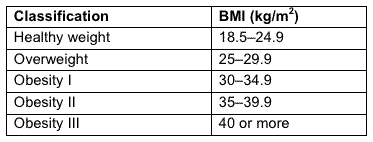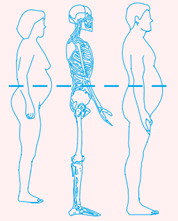 The body mass index (BMI) is often used as a quick estimate of a person's adiposity or leaness. BMI formulae: BMI= weight in kg/height (m)2 or BMI=(weight in lb/ (height in inches)2) X 703. For example, the BMI of an adult over the age of twenty who weighs 225lb and is 67" tall 225/4489 X 703 =35.2. This person is considered grade II obese.
The body mass index (BMI) is often used as a quick estimate of a person's adiposity or leaness. BMI formulae: BMI= weight in kg/height (m)2 or BMI=(weight in lb/ (height in inches)2) X 703. For example, the BMI of an adult over the age of twenty who weighs 225lb and is 67" tall 225/4489 X 703 =35.2. This person is considered grade II obese.
BMI for patients 2-19 yrs. is calculated in the same manner but the result is compared to typical values for persons of the same age and gender. A BMI below the 5th percentile indicates underweight. A BMI between the 85th and 95th percentile indicates overweight. BMI above the 95th percentile is obese.
 Waist measurement may be a better indicator of health risk for patients over 60 years of age than BMI. BMI is often criticizied because it does not differentiate between lean or fat tissue, nor does it address the distribution of body fat. Abdominal fat has long been associated with a greater co-morbidity than peripheral fat deposistion. In a prospective study of > 27,000 men and >41,000 women, Flint and Rexode found that coronary heart disease was more highly correlated with waist circumference in persons over 60 years of age than was BMI.*
Waist measurement may be a better indicator of health risk for patients over 60 years of age than BMI. BMI is often criticizied because it does not differentiate between lean or fat tissue, nor does it address the distribution of body fat. Abdominal fat has long been associated with a greater co-morbidity than peripheral fat deposistion. In a prospective study of > 27,000 men and >41,000 women, Flint and Rexode found that coronary heart disease was more highly correlated with waist circumference in persons over 60 years of age than was BMI.*
National Heart, Lung, and Blood Institute reports that "Men who have waist circumferences greater than 40 inches, and women who have waist circumferences greater than 35 inches, are at higher risk of diabetes, dyslipidemia, hypertension, and cardiovascular disease because of excess abdominal fat. Individuals with waist circumferences greater than these values should be considered one risk category above that defined" by their BMI.*
To measure waist circumference, find the top of the right iliac crest. Place a measuring tape in a horizontal plane around the abdomen at the level of the superior edge of iliac crest. Before reading the tape measure, ensure that the tape is snug, but does not compress the skin, and is parallel to the floor. The measurement is made at the end of a normal expiration.